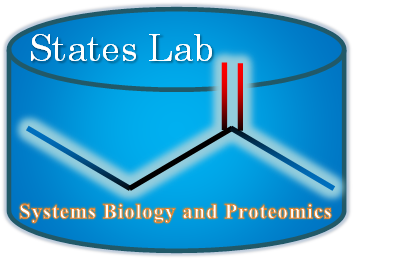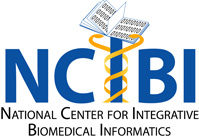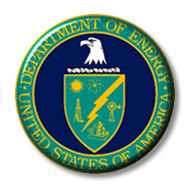David J. States, M.D., Ph.D., FACMIProfessor of Health Information Sciences |
|
David States is a systems biologist and leader who helped to established the discipline of bioinformatics. He received his MD and PhD from Harvard University and clinical training in internal medicine at the University of California, San Diego and the National Institutes of Health in Bethesda, Maryland. He is board certified in internal medicine and is a Fellow of the American College of Medical Informatics. Dr. States has been a leader in establishing bioinformatics as a field including work on molecular modeling, genome mapping and sequencing and proteomics. His contributions include establishing the structured nature of protein folding intermediates (States el al Nature 1980; States et al Journal of Molecular Biology 1987), the widely used molecular dynamics program CHARMM (Brooks et al.; a citation classic), and the development of advanced multidimensional NMR methods (Pure absorption phase spectroscopy in four quadrants, J Mag Res 1982) one of the most highly cited papers in the field of NMR. Dr. States has been involved in the Human Genome Project from its inception and helped to establish the NIH National Center for Biotechnology Information (NCBI). He developed BLASTX with Warren Gish and XNU with Jean Michel Claverie, both tools that led to citation classic papers and remain widely used today. He served as Director of Informatics and later PI of the Washington University Center for Genetics in Medicine assembling the physical map of the human X chromosome. With David Botstein, he demonstrated the feasibility of EST sequencing, and his work on enhanced lane tracking algorithms (Cooper et al, Genome Research 1996) doubled the throughput of the Washington University Genome Sequencing Center and greatly accelerated progress on expressed sequence tags (EST) sequencing. Current work in the States lab focuses on the systems biology of the tumor microenvironment using state-of-the-art mass spectrometry, proteomics and bioinformatics strategies applied to mouse models for ovarian cancers. Dr. States is a member of the founding Board of Directors of the International Society for Computational Biology (ISCB) and served as Treasurer of the Society from 1997 to 2000. He organized the annual meeting of the Society in 1996 and 2005 and remains an active member of the Public Policy and Conferences Committees. Dr. States established graduate training programs in Bioinformatics at Washington University in St. Louis and at the University of Michigan. He was successful as PI in obtaining new T32 training grants at both schools, and both training programs have been ranked in the top 10 nationally. He formulated and established the National Center for Integrative Biomedical Informatics (www.ncibi.org) at the University of Michigan. Dr. States has served on scientific advisory boards for the St. Jude Hartwell Center, Protein Information Resource (PIR) and Gene Ontology (GO), and Wistar Institute. He has been a member numerous NIH study sections and chair of the National Library of Medicine Biomedical Libraries and Information Resources Committee (BLIRC). States, D.J., Dobson, C.M., Karplus, M, Creighton TE. (1980) A conformational isomer of bovine pancreatic trypsin inhibitor protein produced by refolding. Nature. 1980 Aug 7;286(5773):630-2. States, D.J., Creighton, T.E., Dobson, C.M., Karplus, M. (1987)Conformations of intermediates in the folding of the pancreatic trypsin inhibitor. J Mol Biol. 1987 195(3):731-9. States, D.J., Haberkorn, R.A. and Ruben, D.J. (1982) A Two-Dimensional Nuclear Overhauser Experiment with Pure Absorption Phase in Four Quadrants. Journal of Magnetic Resonance, 48, 286-292. Brooks, B.R., Bruccoleri, R., E., D., O.B., States, D.J., Swaminathan, S. and Karplus, M. (1983) CHARMM: A Program for Macromolecular Empirical Energy Modelling. Journal of Computational Chemistry, 4, 187-230. States, D.J. and Botstein, D. (1991) Molecular sequence accuracy and the analysis of protein coding regions. Proc Natl Acad Sci U S A, 88, 5518-5522.Claverie, J.M. and States, D.J. (1993) Information Enhancement Methods for Large Scale Sequence Analysis. Computers in Chemistry, 17, 191-201. Gish, W. and States, D.J. (1993) Identification of protein coding regions by database similarity search. Nat Genet, 3, 266-272. Menon, R., Zhang, Q., Zhang, Y., Fermin, D., Bardeesy, N., Dephinho, R.A., Lu, C., Hanash, S.M., Omenn, G.S., and States, D.J. (2008) Identification of Novel Alternative Splice Isoforms of Circulating Proteins in a Mouse Model of Human Pancreatic Cancer. Cancer Research 69:300-9.
| |









